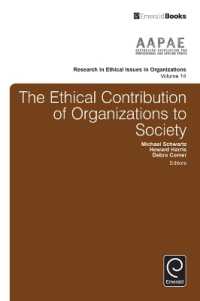- ホーム
- > 洋書
- > 英文書
- > Science / Mathematics
Full Description
Complex networks are key to describing the connected nature of the society that we live in. This book, the second of two volumes, describes the local structure of random graph models for real-world networks and determines when these models have a giant component and when they are small-, and ultra-small, worlds. This is the first book to cover the theory and implications of local convergence, a crucial technique in the analysis of sparse random graphs. Suitable as a resource for researchers and PhD-level courses, it uses examples of real-world networks, such as the Internet and citation networks, as motivation for the models that are discussed, and includes exercises at the end of each chapter to develop intuition. The book closes with an extensive discussion of related models and problems that demonstratemodern approaches to network theory, such as community structure and directed models.
Contents
Preface; Possible course outline; Part I. Preliminaries: 1. Introduction and preliminaries; 2. Local convergence of random graphs; Part II. Connected Components in Random Graphs: 3. Connected components in general inhomogeneous random graphs; 4. Connected components in configuration models; 5. Connected components in preferential attachment models; Part III. Small-world Properties of Random Graphs: 6. Small-world phenomena in inhomogeneous random graphs; 7. Small-world phenomena in configuration models; 8. Small-world phenomena in preferential attachment models; Part IV. Related Models and Problems: 9. Related models; Appendix; Glossary; References; Index.








